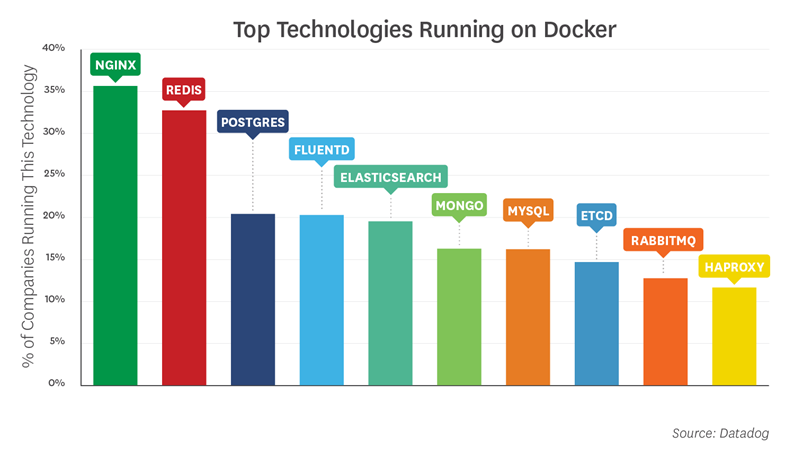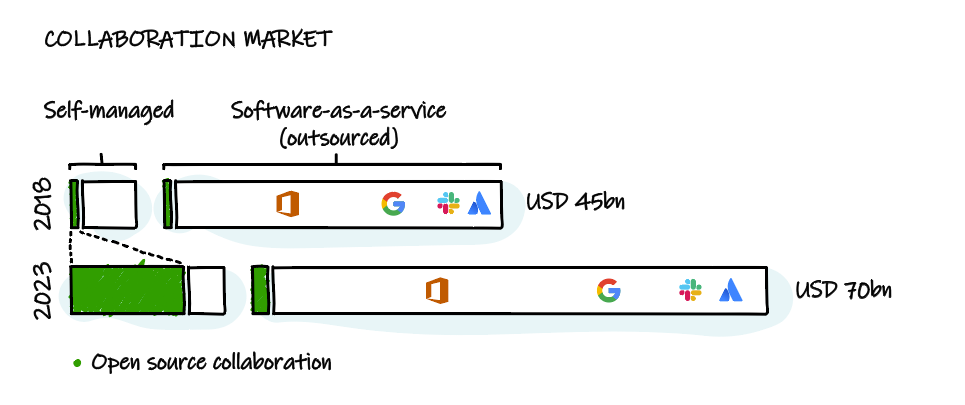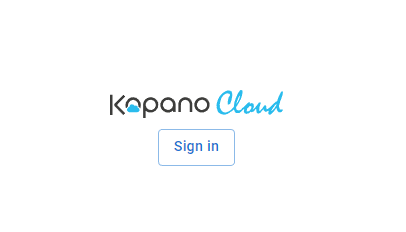Last Christmas, our family discussions were like all others, with two notable exceptions. When I took pictures, my sister asked my daughter not to publish them on social media. This led to an interesting conversation about data privacy. Then, it turned out that my computer illiterate father-in-law (sorry Gerard) has been using LibreOffice for a while now, without realizing it is open source. I wondered, does this mean that open source (software) and its data control claim are getting known among a wider, non-geek audience?
The State of the Collaboration Software Landscape
The collaboration software market is huge and SAAS solutions like Skype for Business, Microsoft Teams and OneDrive are gaining ground. The market share of open source collaboration software, on the other hand, is still very limited ‑ despite several open source collaboration solutions excelling in stability, security and scalability.
So why is that?
One contributing factor is that many of these companies are lagging behind in terms of usability and cost transparency whereas their SAAS competitors are known for their subscription models and user-friendly interfaces.
Despite this, an impressive 200 million companies still run legacy software, most notably Microsoft Exchange. This provides opportunities for vendors of open source collaboration software. Especially those who know how to deliver affordable and easy-to-use software.
And they are on the rise. Based on what I have seen, open source companies are making great progress in improving their cost models and usability.
Transparent Costs and Scalability
When it comes to costs, there are two developments in particular I’d like to point out.
Subscription-based models
There is a growing number open source vendors that offer their software on a subscription basis. They differ from SAAS vendors in a sense that buyers usually do only pay for enterprise-features such as support and software maintenance, and not for software usage itself. This means buyers are vendor-independent which is especially important for most larger organizations.
Containerization
Larger organizations can also benefit greatly from containerization technologies. Solutions like Docker and Kubernetes provide companies with the benefits of the public cloud like scalability and flexibility while maintaining data ownership and control provided by the private cloud.
Developments in Open Source User Experience
Just as important is the rise of an open source collaborative ecosystem with ownCloud, Nextcloud, Seafile, LibreOffice, OnlyOffice, Mattermost, Rocket.Chat, Matrix and other colleagues who got their roots in the open source email domain. In this ecosystem, there has always been the involvement of skilled backend developers, but as of late, huge steps are being made in improving user experience.
In the world of open source at least five things are changing:
- Focus on web and mobile. There is more focus on web and mobile. This enables users to work anytime, anywhere at any device.
- Use of open source web technologies. Developers of open source software benefit from state-of-the-art technologies that were made open source by leading SAAS vendors. React for example, which enables responsiveness and fast user interaction, was developed and made open source by Facebook. At the same time, the rise of user-friendly progressive web apps enables open source vendors and projects to deliver platform independent software to a larger audience.
- Availability of open source user interface (UI) suites. The availability of modern open source UI suites like Material UI, made available by Google enables companies to create the familiar and modern look and feel that the well-known Silicon Valley players offer. Of course, for some of us, this isn’t necessarily a change for the better.
- Availability of advanced open source search functionality. The advanced open source search functionalities offered by Elastic Search, Xapian and SOLR help users to search as easy within open source collaboration suites as they do in SAAS solutions.
- Interoperability through REST APIs. By developing advanced REST APIs, open source vendors help users to shift easily from one application to the other. They also facilitate the integration of software with various clients. An increasing number of players in the open source ecosystem facilitate an integrated user experience by offering joint app bundles.
The arguments mentioned above, show that for SAAS and non-SAAS providers alike, open source is becoming the standard way of developing software.
The Champions of Technology
As for open source email vendors specifically, they have been using quite a few technology champions for years now, giving them a technological advantage over SAAS vendors. The majority of popular backend technologies like those listed below are open source.
- Stable mail transport agents like Postfix and Exim used by 100’s of millions of organizations
- Superior web servers like Apache and nginx for their web apps
- Stable and well-performing databases like MariaDB, MySQL (and of course PostgreSQL and MongoDB)
So what does this all mean for the future of open source collaboration software? It means that if in the coming years, open source collaboration software vendors catch up on usability, users will have easy-to-use, high-quality software at their disposal, without having to share their data with a third party.
I predict that as a result, open source collaboration software will become the next big thing after Office 365 and G Suite. And then I have not even taken into account the argument of open source as the default platform for joint collaboration (like we see happening in in the automotive and aerospace industry). But more about that later.
And Kopano? Yes, at Kopano too developers and designers are working hard to improve the ease of use of our software. Curious how? Stay tuned for the release of our new Meet app and experience how slick and user-friendly open source software can be.
Want to stay updated?
Sign up for our newsletter and receive the latest news and updates directly in your inbox.





